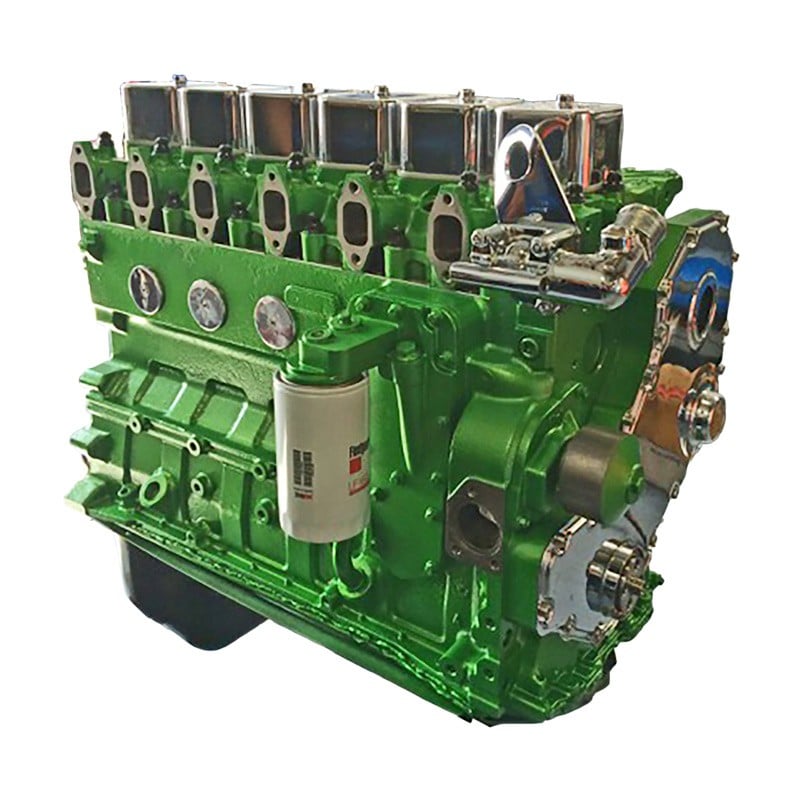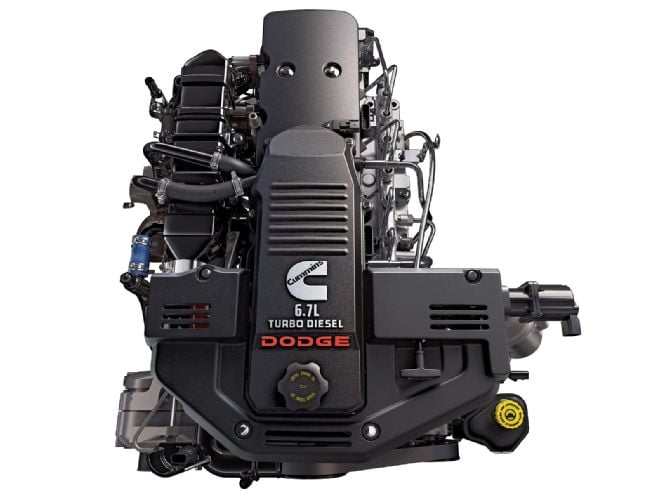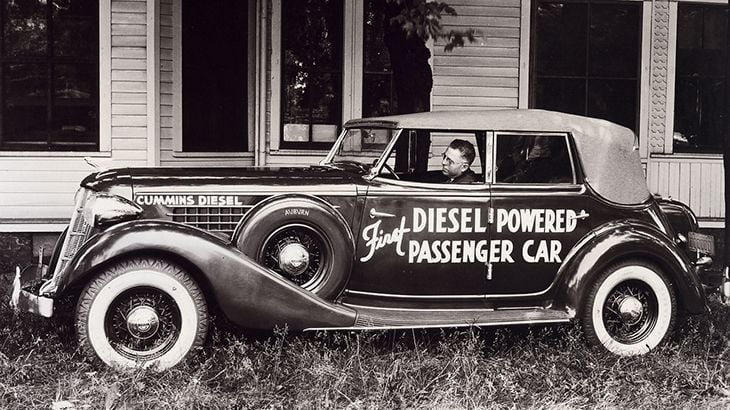Written By: L.T. Tolman
When it comes to pickup trucks, the Cummins engine is the O.G. diesel, end of story. Back in the days when a Corvette was making 240 horsepower and the Beastie Boys were in their prime, Dodge was making waves by installing a turbodiesel which made 400 pound-feet of torque into their Ram pickup. Other diesel engines of the time like the GM 6.2 and Ford IDI’s were slugs by comparison. Since then, the Cummins engine has gone through several changes and updates, and for 2019 you’ll be able to buy a Ram powered by a Cummins which makes 1,000 pounds of torque. We’re going to take a quick look at the history of the Cummins truck engine, some of its strengths and weaknesses, and some of the most common upgrades and fixes to help the legendary straight six last even longer.
5.9 12-valve VE 1989 to 1993
This variant of Cummins was used in stationary power equipment and other industrial machines since the early 80’s, but it was first installed in the Dodge Ram in 1989 and continued until 1993. It’s a 5.9 liter inline six-cylinder turbodiesel with two valves per cylinder. Fuel is injected directly into the cylinder via a Bosch VE rotary style injection pump, and the engines were rated at 160hp and 400lb.ft. of torque, a game-changer for the era when the best gas V8’s were making around 330 pounds of torque. The earliest models were non-intercooled, but in mid-1991, the engines came fitted with an air to air intercooler. It is not uncommon for these early diesels to knock down 24-26 mpg and to last for many hundreds of thousands of miles with little more than basic maintenance. There are a few upgrades which can help extend the life of your Cummins, and it’s not too hard (or expensive) to bump up the power output just a little bit.
One of the first things you should take care of if you own any 12-valve Cummins is the killer dowel pin. Inside the front timing cover is a small steel dowel which aligns the front timing case to the block, but over time, vibration causes the pin to wiggle out of its cavity. When this happens, the dowel earns the nickname Killer, because it’ll wedge itself in between the spinning gears, push them apart, and cause extensive damage to the timing case and the drive gears. The solution is simple; just bolt the dowel in place with an inexpensive kit, and you’ll never have to worry about that pesky little pin again.
The great thing about a mechanically injected engine is how easy and inexpensive it is to increase power. If 160hp isn’t enough, you can swap a few simple parts inside the VE injection pump like a governor spring and fuel pin which will add another 40 horsepower and 90 pounds of torque for less than 170 bucks, but that’s just a starting point. You can add larger or compound turbochargers, bigger injectors, and more. Some builders have even pushed the VE engines to make over 600 horsepower, but honestly, they aren’t an ideal candidate for a high-performance build. However, if you want a fuel sipping daily driver that will run after the apocalypse, or a diesel pickup with a low cost of entry, then a VE-pump 12-valve might be just the ticket.

5.9 12-valve P7100, 1994 to 1998
When Dodge changed the body style of the Ram to the “second gen” in 1994, the Cummins engine powering it also got an upgrade in the form of the Bosch P7100 inline injection pump. While the rest of the engine was very similar, the addition of the P-pump was a game changer. The initial power ratings remained identical to the earlier VE-pump engines, but by 1998 ratings grew to 215hp and 440 pounds of torque for the manual transmission equipped trucks. The P-pump Cummins played a huge part in kick starting the high-performance diesel industry, thanks to how easily you can modify a P7100. Simple changes like an AFC spring kit, governor spring kit and fuel plate can be combined with larger injectors for a very healthy bump in power, and for the most part, the engine will take anything you throw at it, since the pistons, rods, and crank are very strong from the factory.
One area that always should be addressed on a 12-valve is the head gasket. The cylinder pressure inside the engine can overcome the clamping force of the stock bolts and lift the cylinder head slightly off the block, causing a gasket failure. These older engines are simple to work on, so it is certainly worth your while to take the head off and install a gasket kit with new ARP head studs. The new gasket seals in the cylinder pressure, and the ARP studs keep the head clamped in place, even with higher than stock boost pressure.
The P-pump Cummins is like the small block Chevy of the diesel world. They are without a doubt the most commonly swapped engine, have a tremendous performance potential, and there are tons of parts are available for it. Whether you want a daily driver, tow monster, or an all-out competition engine, the P-pump can be made to do it all. Just keep in mind, if you are chasing a higher power numbers (600 or above), a 12-valve might not be as friendly to drive on the street as a later model common rail engine. Since the P7100 and VE-pumps are mechanical, there is no way to dynamically adjust injection timing, so you’ll always have some compromise between low or high RPM power.
5.9 24-valve VP44, 1998.5 to 2002
Halfway through 1998, the 5.9 got a major re-design; the head now featured four valves per cylinder. The 24-valve Cummins is fueled by the electronic Bosch VP44 rotary injection pump. Automatic equipped 24-valves started out making 215 horsepower, but by 2002 manual transmission trucks got a bump in power to 245 horses and 505 pounds of torque. All it takes is a programmer to electronically alter the fuel delivery and add additional power to the engine. A programming module like the Edge Juice with Attitude can add a whopping 120hp and 350 pounds of torque to your VP44 truck, and you don’t even have to get your hands dirty.
There are a few issues to look out for on a 24-valve Cummins, and the first is the 053 block. Certain engines between 1998 and 2002 were cast by the Brazilian manufacturer TUPY and could develop cracks in the outer water jacket. Coolant can leak out, which may lead to overheating if the driver doesn’t pay attention. Not all 24-valves had an 053 block, its estimated about 100,000 are affected. It’s not the end of the world if you have an 053 engine, as the repair process can be quite simple. A simple procedure called stitch and lock involves drilling a series of small holes along the crack and installing threaded inserts to seal up and strengthen the damaged area.
The true Achilles heel of the VP44 is the factory lift pump. While the earlier P7100 pump used engine oil for lubrication, the VP44 relies on fuel from the tank. If the lift pump fails and fresh fuel is no longer being sent to the engine, the injection pump will lack vital lubrication, damaging the VP44, and leading to very costly repairs. A great first mod on a VP44 truck is to replace the stock lift pump with an aftermarket FASS system which can reliably provide a steady supply of clean fuel to the injection pump with the added benefit of better filtration and all the air being removed from the fuel, resulting in longer injector life, better mileage, and of course a happier injection pump.
5.9 Common Rail, 2003 to 2007
In 2003, Dodge updated the body style of the Ram again, and the Cummins finally came equipped with common rail fuel injection, powered by another Bosch pump, this time the CP3. Common rail injection uses a single rail of high-pressure fuel (max of about 26,000 psi) and an electronic solenoid style injector to deliver a precise amount of fuel directly into the cylinder. This new technology gave many benefits, like a broader power band and lower emissions output. Today, triple digit horsepower from a common rail 5.9 is easily attained, and thanks to advances in tuning and turbocharging, you can even daily drive a high-powered common rail truck with very little drama, and relatively smoke free operation, something that the earlier P and VE-pumps could never pull off.
When looking for more power from a common rail truck, avoid the temptation to stack in-line modules and flash tuning together. The thought is you’ll gain tons of power from having two types of tuning, but “stacking” can cause an unanticipated increase in injection timing and pulsewidth beyond safe values, adding much more fuel than the engine can safely burn. Stacking can cause excessive smoke and exhaust gas temperature, leading to possible internal damage and melted pistons. Several quality “box programmers” are available that can safely increase power levels, and now HP Tuners covers the early model dodge common rails, meaning shops like Hardaway Performance can craft full custom tunes for any parts combination, giving safe yet substantial gains in power which won’t cause a mini Chernobyl inside your Cummins.
One issue the early common rail trucks were plagued by is injector failures. As the miles build up, the fuel injectors can become worn, and you will first notice symptoms like hard starting, rising engine oil level, rough running, or excessive smoke from the exhaust. If you ignore the warning signs and continue to drive a truck with a failing injector, you can cause a catastrophic failure. Extra fuel will leak down into the cylinder, wash past the piston rings, and get into the crankcase oil. Fuel diluted oil causes less pressure and lack of lubrication on the cylinder walls, and too much fuel leaking into the cylinder can even cause a run-away condition which might over rev your engine. Combine that with scored cylinder walls and melted pistons, and obviously you’ll be looking at a full engine rebuild PLUS the cost of new injectors, so this is something to pay close attention to. If you have a monitor like the Edge Insight CTS2, you can check injector balance rates, and identify which injector is failing before it’s too late. If your injectors are failing, you can replace just one at a time to save on cost, or if you are looking for a performance gain you could take advantage of the opportunity and swap all six for a larger set.

6.7 Common Rail, 2007 to present
Halfway through 2007, the 5.9 Cummins was retired, and it was replaced by its larger and more powerful 6.7-liter brother. It still featured 4 valves per cylinder and still used the CP3 injection pump, but there were several new emission control systems like EGR and DPF. Initially, the 6.7 was rated at 350 horses and 610 pounds of torque for the manual trans, but a few years later in 2016, you could order a Ram 3500 with a whopping 385hp and 900 pounds of torque.
In the early years, the 6.7 had some problems with the DPF system clogging up prematurely, but luckily Dodge released a new ECM calibration early on which would remedy the issues. The 6.7’s are known among enthusiasts to be some of the most reliable diesels out there. The engine by itself is very strong under stock conditions, but you can run into some trouble with a 6.7 if you get a bit too eager with the tuning. Before doing any power upgrades, it’s a good idea to pull the valve cover and throw in a set of pushrods, valvesprings, and head studs to keep the valvetrain stable at higher RPM and the combustion pressure sealed inside the engine where it belongs.
Because of its inline design, the rear two cylinders on the 6.7 don’t get a lot of coolant flow and tend to run hotter than the rest. In extreme towing or racing conditions, there can be enough heat built up to cause damage to the rear cylinder. Excessive pressure can also build up in the cooling system and blow out the freeze plugs. A simple and effective fix for both problems is to install a Fleece Coolant Bypass which improves circulation throughout engine, preventing excessive heat and pressure, and ensuring consistent temperature across all six cylinders.
No wrong choices
Cummins holds the title for the longest running diesel engine in a pickup truck by a wide margin, and there’s good reason. They are powerful, reliable, and are usually the most fuel-efficient engine in their class. With only a few basic fixes or tweaks, you can eliminate any weakness, bump up the power a bit, and enjoy many years of trouble-free operation. The only question is if you prefer the old-school P-pump 12-valve or the high-tech 6.7 common rail.


Very informative and fruitful. And i think 2007 to now the cummins engine upgraded most